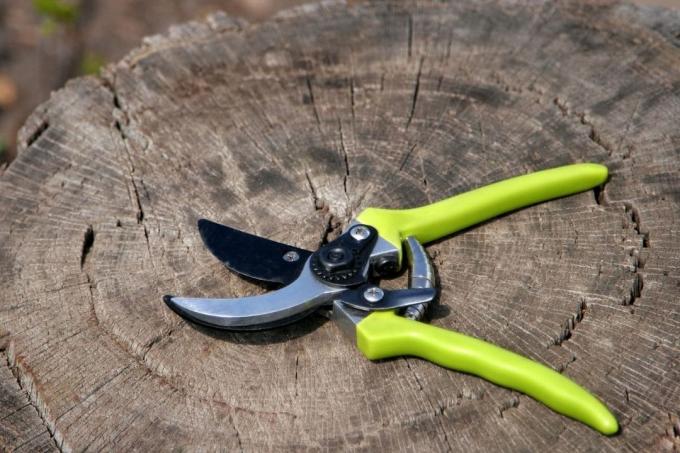
table of contents
- Best time
- Phlox flowering period
- Autumn cuts
- Spring cut
- Occasional clipping
- Cutting technique
- Delay flowering
- Cutting creeping phlox
- frequently asked Questions
Cutting phlox is not absolutely necessary, but has various advantages. Find out which, when and how best to use the cutting tool.
In a nutshell
- Cut phlox to stimulate renewed flowering (remount)
- Correct cutting time is decisive for new growth
- always use cleaned cutting tools
Best time
There are various “right” times when it is advisable to cut back the flame flowers. Below we tell you when to cut phlox.
Phlox flowering period
The best time to stimulate a second or second bloom is just before the onset of the wilting flowers. Even if cutting is difficult due to the still beautiful looking flowers, this time should not be missed. As the wilt progresses, the seeds form. To do this, the plant invests a lot of energy, which is then lacking for renewed flower formation. When pruning flowers, please note the following:
- Use disinfected, sharp cutting tools
- Start the cut before the first leaves
- During the main flowering period, look for traces of wilting on the flowers at least every two days and remove them if necessary

Autumn cuts
A phlox should be pruned in autumn if it is weakened after a disease or a pest infestation. Theoretically, the annual pruning can also take place here if the wood has withered by then. As a rule, this only applies to varieties whose flowering period ends in July or early August at the latest. Even with the high one Perennials-Phlox (Phlox paniculata) as well as the large-leaved phlox (Phlox amplifolia) die off numerous branches and can be cut out in autumn. However, it offers an ideal place to hide and as winter quarters for all kinds of animal garden visitors. In addition, the dead parts of the plant form a natural protection against the cold for the roots.

Autumn and evergreen varieties
Phlox varieties that bloom into late summer or fall and / or stay green through the winter months should be in fall not get cut. Your branches are too fresh. Since there is usually high humidity due to the cold, there is an increased risk of fungal infections. In addition, cutting weakens every plant, which should collect its energy for wintering.
Tip: If you cut the blossoms of autumn bloomers shortly after the start of wilting, you will prevent seeds from spreading in the garden and consequently unwanted, uncontrolled wild growth. A renewed bloom in winter is, however, due to it not to stimulate.

Spring cut
The best time to prune a phlox is in spring. Important details should be observed here:
- cut shortly before the start of vegetation (usually between early February and mid-March)
- do not cut earlier, as flame flowers need their winter dormancy
Occasional clipping
With all phlox species it occasionally happens that parts of the plant die off or dry up. These can be cut out at any time between early spring and late autumn. This ensures a more neat overall appearance, at the same time promotes branching and, ideally, new shoots for more flowers.
Cutting technique
The right cutting technique depends on whether it is winter or summer green phlox species. Although both are about stimulating new growth, a different pruning technique is required:
- Cut back the evergreen species by two thirds
- Shorten withered phloxes to a hand's breadth

Delay flowering
If the flowering time of your flame flowers seems too early, you can delay the beginning of flowering by cutting and postpone it. This is useful if you cannot enjoy the earlier blooms due to a vacation, for example. Here, the cut is made before the buds are formed. With the right cutting technique, there is increased branching. New buds will form on the new branches and consequently the flowers will show up later. This practice has been "discovered" in England and is known as the "Chelsea Chop Cutting Technique".
The following should be taken into account:
- Best time: late May to early June
- Shorten shoots by a third
- Delay period: between four and six weeks
- only applicable for tall flame flowers
Tip: With the special cutting technique, you can not only delay the formation of flowers, but also extend the flowering period. To do this, just cut off a few shoots so that some of them bloom at the regular time and this is followed by the delayed bloom formation.
Cutting creeping phlox
A specialty among the phlox species are the ground-covering variants: upholstery or carpet phlox (Phlox subulata). With maximum heights of between 15 and 20 centimeters, there is not much space left for cutting. However, it is advisable under certain circumstances.

Cutting instructions
In the case of the turf-like growing flame flower species, renewed flowering is also possible if the old one is cut off when the wilting begins to appear. An annual pruning is not necessary, however, as is recommended for tall flame flowers. However, the ground cover thins out over the years. Usually this starts from the middle. To prevent this, a so-called tapering cut or radical cut is advisable at regular intervals.
- Cut rhythm: every two to three years
- Best time: spring before new shoots begin
- radical cutting back to a third or just under a hand's breadth

So that the ground-covering phloxes quickly form new side shoots and thus again cover the whole area you should use a suitable liquid fertilizer in low dosage after cutting administer. This promotes the growth of new lateral shoots in particular.
frequently asked Questions
As a rule, they do not need rescue. The death of above-ground parts of plants is normal for many phlox species over the winter. In spring they sprout again as usual. It is still advisable to cut off the dead remains in early spring so that they do not spoil the appearance.
If you want to get a denser growth in your carpet phlox, cut it as described in this article. This procedure when cutting serves to prevent light spots as well as to stimulate denser growth. If necessary, a cut back can be made every year. With an average growth rate of around ten centimeters per year, your carpet phlox will quickly regain fullness after it has been cut.
Mostly nothing - at least not with the species that bloom during the summer months. However, if you cut off fresh parts of the plant, there is not only an increased risk of infection but also the risk of frostbite. In the worst case, frost pulls through the sap to the roots and the flame flowers die. Therefore, as much as possible dead parts of the plant should be cut off in autumn. It is better to always wait until spring.
After transplanting, you should definitely wait until the roots have solidified before cutting. Only then can the plant be optimally nourished and it can withstand the rigors of pruning without any problems. Since transplanting should never be carried out when the flowers are in full bloom, this time is also omitted for subsequent cutting.
